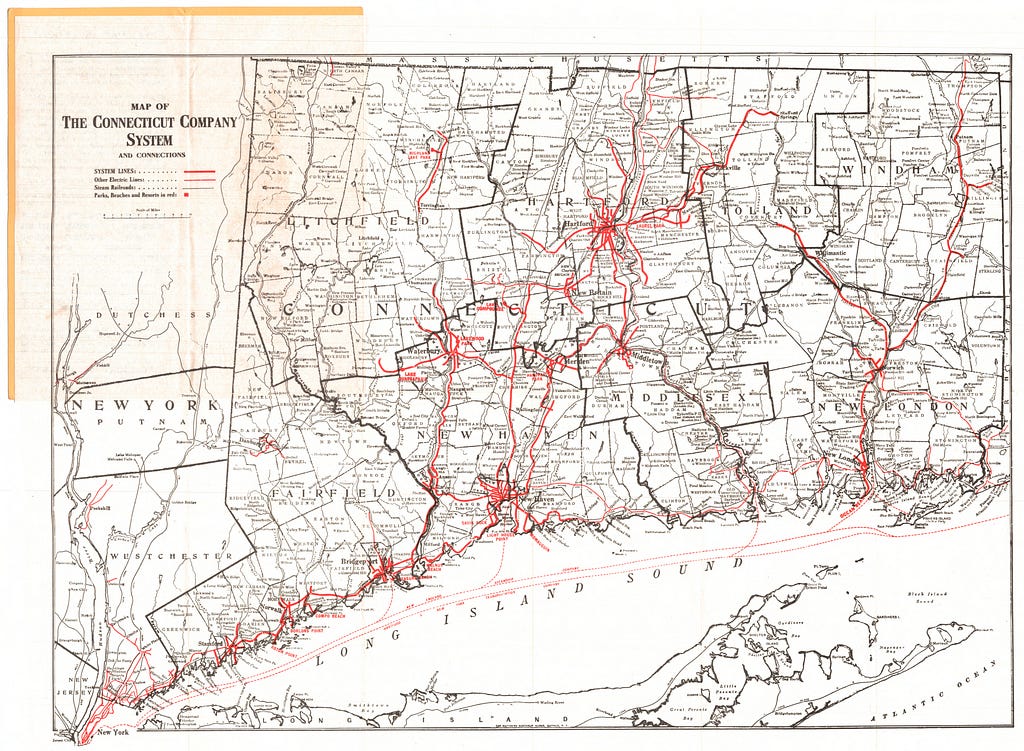Everyone Benefits with More Connections Between Our Cities, Towns, and Institutions

One of the greatest transit planning tragedies in the U.S. was the demise of its streetcar system found across the country in the early 20th century. An article in Vox discusses its downfall and panned it well:
The real problem was that once cars appeared on the road, they could drive on streetcar tracks — and the streetcars could no longer operate efficiently.
There were other policies at play that led to their downfall, including maintenance and fare contracts, but something more subvert and indirect is to blame: inequitable government policies that subsidized car travel more than transit.
Unfortunately, such policies continue to this day: just look at New York City, millions of on-street parking spaces, and more than 95% of them free.
Recently some U.S. cities are looking to revive streetcars and other light rail systems. Oklahoma City opened a 4.8-mile system that serves the greater downtown area in early 2018. And last year Houston, TX approved a $3.5 billion bond authorization to help pay for its METRONext Moving Forward Plan.
While some cities have made progress, others haven’t been as fortunate. In 2018, voters in Nashville, TN rejected a $5.4 billion transit expansion by a wide margin. The Transit Center completed a study earlier this year (“Derailed”) outlining what lead to the defeat and provides useful insights for areas looking to expand transit.
Looking at The Biden Plan, there is a lot of support for transit. According to the plan he will:
Increase flexible federal investments to install light rail networks and to improve existing transit and bus lines.
Help cities invest in infrastructure for pedestrians, cyclists, and riders of e-scooters and other micro-mobility vehicles.
Work to make sure that new, fast-growing areas are designed and built with public transit in mind.
All of these sound great and would be helpful to improve mobility, reduce congestion, and spur growth. But barriers to projects should be removed or addressed early while getting communities and stakeholders on board.

A setback for light rail in the state of North Carolina occurred a couple years ago. Despite decades of planning, study and investment, the Durham-Orange Light Rail Transit Line was discontinued following objections by Duke University in 2018. Insufficient time to accommodate their objections to change the path of the rail line lead to the project being shelved. What’s unsettling about the whole process is that Duke had years to raise these objections and waited until the project was nearly ready to break ground before doing so. Now, the region missed out on an opportunity to improve connectivity.
It is setbacks like the one in North Carolina and Nashville (along with many others) that place the nation’s transit systems behind that of most western nations.
If you want to see where light-rail works well, look at Australia. In Melbourne, there is a “Free Tram Zone” throughout the central business district making it easier for commuters and tourists to move around the city. Sydney is another example, with light rail arriving to the city in 1997 and new lines opening recently in December 2019 and April 2020.
In a Dec. 2012 report the government of New South Wales commented on Sydney’s light rail future and noted:
To thrive on the global stage, Sydney needs to offer high transport capacity, easy access from all parts of the city and a high quality urban environment to attract international business and tourists.
Investing in light-rail promotes economic growth, creates a valuable public asset, and connects people around the area to provide new opportunities. It can also mitigate congestion and pollution.
Indiana broke ground this week on an 8-mile South Shore extension, the commuter rail line from South Bend, IN to Chicago. According to the Governor the project is “the largest transit investment in Indiana’s history.” The project, which is funded through a mix of federal, state and local dollars, costs around $945 million.
The project includes four new stations and construction is expected to finish in late 2024 with passenger service starting in early 2025, according to a press release from the Governor’s office. In addition to the new line, another project will double track parts of the South Shore Line and reduce travel time.
Also from the press release:
Combined, the Double Track Northwest Indiana and West Lake Corridor projects are projected to attract approximately $2.3 billion in private investment to northwest Indiana, and result in over 6,000 new jobs and $3 billion in economic impact by 2048.
The project is a major step forward for commuter rail to an existing service line, increasing the number of people with transit access to Chicago and South Bend, IN.
No one knows what the future holds for transit after coronavirus is no longer a threat, but it must remain part of the country’s future. It’s good to see projects like the one in Indiana break ground. The more connections between cities, towns, and institutions, the more regions can thrive and opportunities can expand.
It is encouraging to see the commitments in Biden’s plan and hope politicians at the state, regional, and local level continue to support these projects. However, more federal money needs to flow to transit. But equally important, transit needs more advocates within all levels of government.
For more of my thoughts and what I’m currently reading, follow me on Twitter @WhatTimTweets. Tweets and any opinions are my own.



